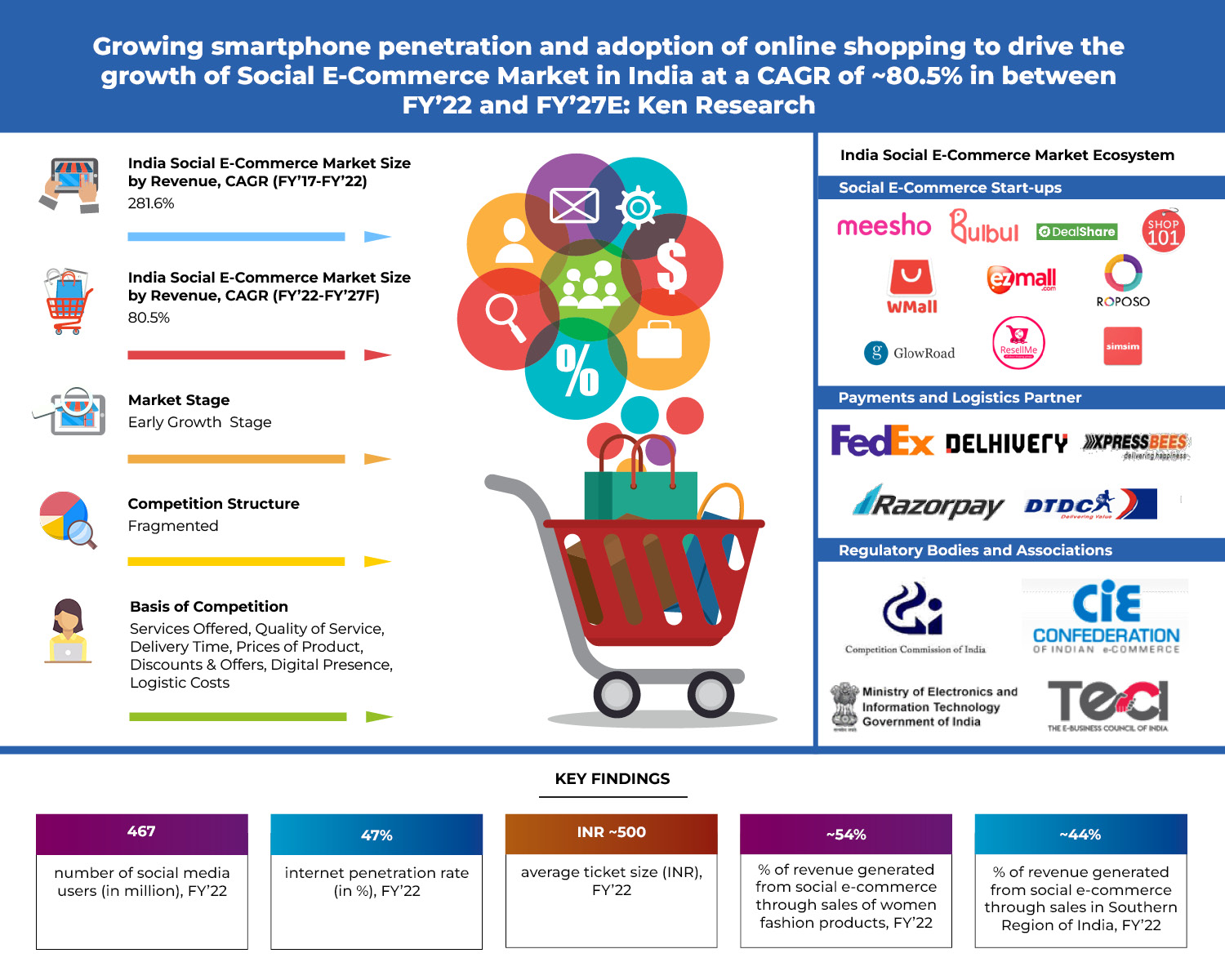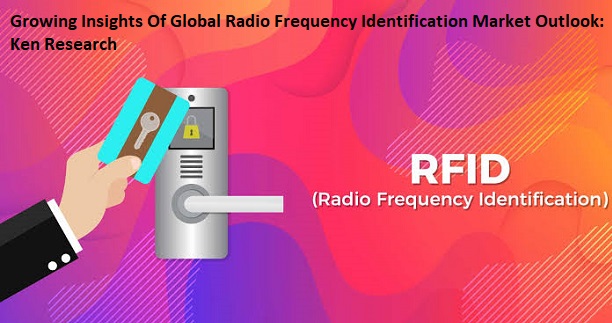Overview Of India Social E-Commerce Industry And Market Size
India social e-commerce market industry expanded with a CAGR of XX% in between FY’17 and FY’22 on the basis of revenue generated. One of the major determinant of the surging growth of social e-commerce market is attributed to the digital boom, backed by higher internet and smartphone penetration rate in India. Consumers changing preference towards purchasing customized products through digital medium post COVID-19 and the convenience of interaction between buyers and sellers that social e-commerce platforms offer acted as a catalyst for the surging growth. Coupled with that, “Digital India” initiative launched by the government of India in FY’15 to ensure improvement in online infrastructure and citizen’s digital literacy contributed in the adaptation to social e-commerce platforms. Due to the huge potential of the market, leading e-commerce players such as Myntra, and Flipkart among others initiated the process of integrating the ecosystem by diversifying its business or through acquisitions in recent years. In FY’21, Walmart owned fashion retailer Myntra announced the launch of M-Live, a social commerce platform extending interactive and real time shopping experience to its customers.
Furthermore, consumers shifting preference towards availing digital medium for their daily purchases followed by the advent of COVID-19, resulted in the growing use of social e-commerce platforms. Majorly consumers in India avail social e-commerce platforms for purchasing food products, electronics, fashion products, home & kitchen appliances and personal care. Realizing the massive potential of the India Social E-Commerce Market which is currently in the nascent phase, various home grown start-ups have ventured in the social commerce business to capitalize on this opportunity as of FY’22. Integration of these start-ups in the ecosystem opens up avenue for the sellers especially from Tier 2 and Tier 3 cities. With the growing popularity of social commerce, international social media platforms such as Facebook have initiated the process of innovating and implementing new features to make it convenient for sellers and buyers to interact in order to integrate the social e-commerce space by utilizing their large customer base. On the other hand, integration of international brands in the ecosystem is expected to deter the business prospect of home grown brands in coming years. In FY’20, Facebook family which includes Instagram revamped their platforms and added new tools to aid social commerce. Some of their features include assisting the retailers to create new store fronts and increase the number of users visit through paid advertising.

To learn more about this report Download a Free Sample Report
India Social E-Commerce Market Segmentation, FY’22
By Start-up (Meesho, DealShare, Shop 101, Roposo, GlowRoad, Simsim and Others):
Meesho contributed to the majority share of XX% on the basis of revenue generated in FY’22 followed by DealShare and Shop 101. Consumers especially from lower Tier cities preferred availing these platforms due to the wide range of products available and lower average ticket size as compared to e-commerce platforms such as Amazon and Flipkart.
By Category (Women Fashion, Home & Kitchen, Men Fashion, Beauty & Grooming, Electronics and Others):
Women fashion products were the most demanded in FY’22 from social commerce platforms, which accounted for the highest revenue share of XX%. Consumers preferred fashion products due to their low ticket size as compared to electronics in FY’22, as these consumers were majorly from Tier 2 and Tier 3 cities with lower spending capability.
By Region (Northern, Eastern, Western and Southern):
Revenue generated from sales of product on social e-commerce platforms from Southern region contributed to the highest share of XX% FY’22.
By Gender (Female and Male):
The target customer base for these social commerce platforms are majorly women from Tier 2 and Tier 3 cities. Therefore, on the basis of gender, women consumers contributed to the highest revenue share of XX% in FY’22 from sales of products on social commerce platforms.
By Gender (Female and Male):
The target customer base for these social commerce platforms are majorly women from Tier 2 and Tier 3 cities. Therefore, on the basis of gender, women consumers contributed to the highest revenue share of XX% in FY’22 from sales of products on social commerce platforms.
By Ticket Size (Less than INR 500, INR 500-1000, and INR 1000-5000 and More than INR 5000):
Since most of the social e-commerce customers were from lower Tier cities as of FY’22, one of their major determinants to consider is the pricing of the product. As consumers have the convenience to choose a specific product from different platforms, these consumers generally prefer purchasing products through a platform offering lower ticket size of products. Revenue generated from sales of product on social e-commerce platforms with ticket size less than INR 500 accounted for the highest share of XX% in FY’22.
By Platform (Mobile Application, WhatsApp, Facebook, Instagram, Website and Others): Mobile applications (social e-commerce mobile applications) were the most availed platform while purchasing products from social e-commerce platforms, contributing to the highest share of XX% on the basis of revenue generated in FY’22.
Competitive Landscape in India Social E-Commerce Market, FY’22
The India social e-commerce market is highly competitive and is currently in the nascent phase. There exist significant competition among the players due to lack of product differentiation and no switching cost for customers. Players compete on the basis of pricing of products as well as other factors that influence buyers’ choice such as delivery time, product quality, digital presence, logistic costs, customer service and discounts & offers among others. The average ticket size of products sold through social e-commerce platforms stood at INR~XX as of FY’22. Major players in the ecosystem includes Meesho, DealShare, Shop 101, Bulbul, Roposo, GlowRoad and Simsim among others
Future outlook of India Social E-Commerce Market, fy’22-fy’27E The market size on the basis of revenue is expected to grow at a five-year CAGR of XX% in between FY’22 and FY’27E. With improved online ecosystem and internet connectivity expected in coming years, buyers and sellers especially from rural regions, Tier 2 and Tier 3 cities will be better connected through a digital ecosystem. The improved digital connectivity across these regions will aid the surging growth of social e-commerce market in India in between FY’22 and FY’27E. Further, the improved digital connectivity also extends a platform to sellers from rural regions, Tier 2 and Tier 3 cities to market their products to a larger consumer base. Product owners customizing content according to local language of the individuals will be the norm in the social e-commerce domain to create a lasting impact in coming years. The social e-commerce market in India will undergo rapid transformation with the integration of various home grown start-ups entering the market. Start-ups such as Bikayi, Dukaan Plus and Big Living among others have already initiated the process of venturing into the social e-commerce space due to its huge potential as of FY’22. Increasing adaptation among consumers to these platforms will further encourage the social e-commerce platforms to implement advanced technological solutions in order to protect consumer’s personal information.
Key Segments Covered in India Social E-Commerce Market
- By Start-up
- Meesho
- Dealshare
- Shop101
- Roposo
- GlowRoad
- Simsim
- Others
- By Category
- Women Fashion
- Home & Kitchen
- Men Fashion
- Beauty & Grooming
- Electronics
- Others
- By Age of Users
- Below 20 Years
- 20-40 Years
- 40-60 Years
- Above 60 Years
- By Region
- Northern Region
- Southern Region
- Eastern Region
- Western Region
- By Gender
- Male
- Female
- By Platform
- Mobile Application
- Website
- Others
Request for Sample Report @ https://www.kenresearch.com/sample-report.php?Frmdetails=NTc0NDQ4
- By Ticket Size
- Less than INR 500
- INR 500-1000
- INR 1000-5000
- More than INR 5000
Key Target Audience
- Current Incumbents in the Social E-Commerce space
- Companies looking to enter the Social E-Commerce space in India
- PE/VC Firms
- Industry Associations
- Government Bodies
Time Period Captured in the Report:
- Historical Period: FY’17-FY’22
- Forecast Period: FY’22-FY’27E
India Social E-Commerce Players
- Startups
- Meesho
- Bulbul
- Dealshare
- com
- GlowRoad
- Trell
- WMall
- Roposo
- ResellMe
- Shop101
- Mall91
- Simsim
- Yaari
- Shopsy
- Payments and Logistics Partners
- DTDC
- XpressBees
- FedEx
- Razorpay
- Delhivery
- Regulatory Bodies and Associations
- TECI (The E-Business Council of India)
- Ministry of Electronics and Information Technology, Government of India
- CCI (Competition Commission of India)
- CIE (Confederation of Indian E-Commerce)
Key Topics Covered in the Report
- Overview of Social E-Commerce Market in India
- Internet Penetration Rate and Number of Social Media Users in India
- Ecosystem of Major Entities in India Social E-Commerce Market
- Market Size of India Social E-Commerce Market (Basis Revenue in INR Crore)
- Average Ticket Size of Social E-Commerce
- India Social E-Commerce Market Segmentation (By Startup, By Category, By Age of Users, By Region, By Gender, By Platform, By Ticket Size)
- Trends and Developments in India Social E-Commerce Market
- Issues and Challenges in India Social E-Commerce Market
- Porter 5 Forces Analysis of India Social E-Commerce Market
- Government Regulations in India Social E-Commerce Market
- Impact of COVID-19 on India Social E-Commerce Market
- Cross Comparison of Major Social E-Commerce Players (on the basis of Year of Establishment, Number of Employees, Geographic Presence, Investment Raised, Average Transaction Size, Fees and Commissions Charged, Number of Registered Sellers, App Downloads, Active Users, Marketing Strategies, Recent Developments)
- Strengths and Weaknesses of Major Social E-Commerce Players
- Cross Comparison of Major Social E-Commerce Players on the basis of Financial Parameters (Total Revenue for FY’19, FY’20 and FY’21; Total Expenses for FY’21, Other Expenses for FY’21, Current Assets for FY’21, Current Liabilities for FY’21)
- Company Profiles of Major Social E-Commerce Players (Company Overview, Product Portfolio, Revenue Streams, Business Strategy, USP)
- TAM, SAM and SOM for Social E-Commerce Market in India
- Future Market Size of India Social E-Commerce Market (Basis Revenue in INR Crore)
- India Social E-Commerce Market Future Segmentation (By Startup, By Category, By Age of Users, By Region, By Gender, By Platform, By Ticket Size)
- Analyst Recommendations
- Industry Speaks
- Research Methodology
For more information on the research report, refer to below link:-
India Social E-Commerce Market Outlook to 2027 (Second Edition): Ken Research
Related Reports
Follow Us
LinkedIn | Facebook | Twitter | YouTube
Contact Us:
Ken Research
Ankur Gupta, Head Marketing & Communications
Support@kenresearch.com
+91-9015378249

